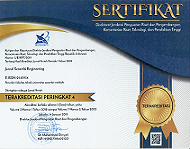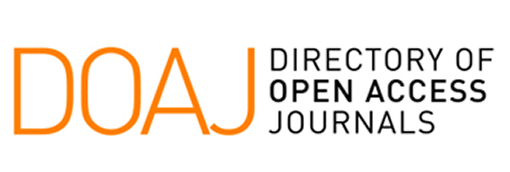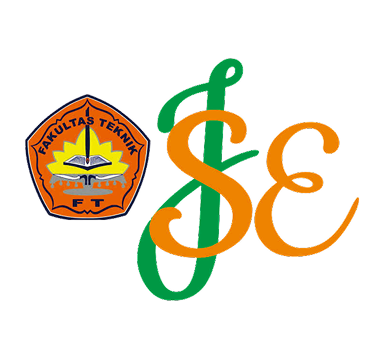Implementasi Metode FMEA untuk Mereduksi Cacat Produk pada Proses Produksi Sandal di Departemen Plong
Keywords:
Cacat Produk, FMEA, Industri Alas Kaki, Pengendalian Kualitas, RPNAbstract
CV. Bossbi, as one of the sandal manufacturers, faces challenges related to defective products originating from the initial production process. This study aims to implement the Failure Mode and Effect Analysis (FMEA) method to identify, analyze, and prioritize corrective actions to reduce product defects in the Plong Department. This study uses a quantitative descriptive approach with data collection for two months (January-February 2025) through observation and interviews. The results of the study identified three dominant types of defects from a total production of 177,990 pairs of sandals, namely asymmetrical patterns (39.95%), uneven edges (31.14%), and inappropriate sizes (28.92%). The FMEA analysis produces a Risk Priority Number (RPN) value for each failure mode, where 'asymmetrical patterns' obtained the highest RPN value of 224, followed by 'inappropriate sizes' (RPN = 189), and 'uneven edges' (RPN = 175). The highest RPN value indicates that 'asymmetrical pattern' is the most critical risk caused by imprecise material placement and rushed operators. Based on these priorities, it is recommended that corrective actions be taken in the form of making jigs (assistive tools), standardizing operational procedures (SOPs), and scheduling regular machine maintenance. The implementation of FMEA has proven effective as a tool for mapping risks and providing a basis for measurable improvement proposals to significantly improve product quality.
References
[1] M. Herman Djaya, “Pengaruh Kualitas Produk dan Promosi Produk Terhadap Keputusan Pembelian,” Abhakte J. Pengabdi. Kpd. Masy., vol. 1, no. 2, pp. 16–24, 2023, doi: 10.24929/abhakte.v1i2.3053.
[2] A. Suherman and B. J. Cahyana, “Pengendalian Kualitas Dengan Metode Failure Mode Effect And Analysis (FMEA) Dan Pendekatan Kaizen untuk Mengurangi JumlahKecacatan dan Penyebabnya,” Semin. Nas. Sains dan Teknol., vol. 16, pp. 1–9, 2019.
[3] A. Nurholiq, O. Saryono, and I. Setiawan, “Analisis Pengendalian Kualitas (Quality Control) Dalam Meningkatkan Kualitas Produk,” J. Ekonologi, vol. 6, no. 2, pp. 393–399, 2019, [Online]. Available: https://jurnal.unigal.ac.id/index.php/ekonologi/article/download/2983/2644
[4] A. Latip, B. A. Irawan, D. D. Syafira, and G. W. Puspita, “Upaya Pengurangan Produk Cacat Dengan Metode DMAIC Di PT . AYW ( Studi Kasus Pada PT AYW ),” vol. 03, no. 01, pp. 1–7, 2025.
[5] A. Iswanto, A. Jabbar, M. Rambe, and E. Ginting, “Aplikasi Metode Taguchi Analysis Dan Failure Mode And Effect Analysis (FMEA) Untuk Perbaikan Kualitas Produk Di PT. XYZ,” J. Tek. Ind. FT USU, vol. 2, no. 2, pp. 13–18, 2013.
[6] S. Masnun, M. Makhdalena, and H. Syabrus, “Pengaruh Kualitas Produk terhadap Kepuasan Konsumen,” JIIP - J. Ilm. Ilmu Pendidik., vol. 7, no. 4, pp. 3736–3740, 2024, doi: 10.54371/jiip.v7i4.4280.
[7] Pratama, Sigit Adi, Muhammad Fahreza, and Miwan Kurniawan Hidayat. "Analisis Pengendalian Kualitas Produk Menggunakan Metode SQC Dan Kaizen Pada PT. Laksana Tekhnik Makmur." IMTechno: Journal of Industrial Management and Technology 6.1 (2025): 1-8.
[8] A. E. Terang, N. Anggraini, and P. Noermaning, “Analisis Perlakuan Akuntansi Produk Rusak Dan Produk Cacat Dalam Perhitungan Harga Pokok Produksi Untuk Mengoptimalkan Laba Produk (Studi Kasus Pada CV. Memory Nganjuk),” JCA (Jurnal Cendekia Akuntansi), vol. 4, no. 1, p. 25, 2023, doi: 10.32503/akuntansi.v4i1.3548.
[9] A. B. Rizkyllah and Y. C. Winursito, “Analisis Cacat Produk pada Line Produksi Mesin IDAH dengan Metode Seven Tools dan Kaizen,” vol. X, no. 1, pp. 12097–12105, 2025.
[10] M. Y. Balaka, “Metode penelitian Kuantitatif,” Metodol. Penelit. Pendidik. Kualitatif, vol. 1, p. 130, 2022.
[11] N. I. Muvidah, E. W. Yunitasari, and K. Kusmendar, “Pengendalian Kualitas Produk Menggunakan Lean Six Sigma dan Fuzzy FMEA Dalam Upaya Menekan Kecacatan Produk,” J. Engine Energi, Manufaktur, dan Mater., vol. 7, no. 2, p. 86, 2023, doi: 10.30588/jeemm.v7i2.1617.
[12] A. Wicaksono and F. Yuamita, “Pengendalian Kualitas Produksi Sarden Mengunakan Metode Failure Mode And Effect Analysis (FMEA) Dan Fault Tree Analysis (FTA) Untuk Meminimalkan Cacat Kaleng Di PT XYZ,” J. Teknol. dan Manaj. Ind. Terap., vol. 1, no. 3, pp. 145–154, 2022, doi: 10.55826/tmit.v1iiii.44.
[13] S. F. Zahari and A. Chirzun, “Analisis Pengendalian Kualitas Produk Celana di PT. Alpina Menggunakan Peta Kendali dan FMEA,” Pros. Ind. Eng. Natl. Conf., pp. 200–206, 2020.
[14] R. Triwidayat Utami, N. Luh, P. Hariastuti, J. T. Industri, T. Adhi, and T. Surabaya, “Analisis Kecacatan Produk Menggunakan Metode FMEA Dan FTA Pada PT.XXX,” Semin. Nas. Sains dan Teknol. Terap. IV, pp. 291–300, 2016.
[15] D. Nurhayati and E. Yuliawati, “Perbaikan Kualitas Produk Sandal Japit Dengan Menggunakan Metode Failure Mode and Effect Analysis (FMEA) Dan Fault Tree Analysis(FTA),” Semin. Nas. Sains dan Teknol. Terap. VII, pp. 169–176, 2019.
Downloads
Published
Issue
Section
License
Copyright (c) 2025 Mochamad Amiruddin, Abdul Wahid (Author)

This work is licensed under a Creative Commons Attribution 4.0 International License.












